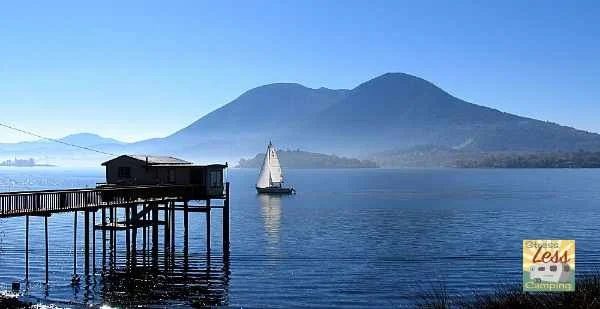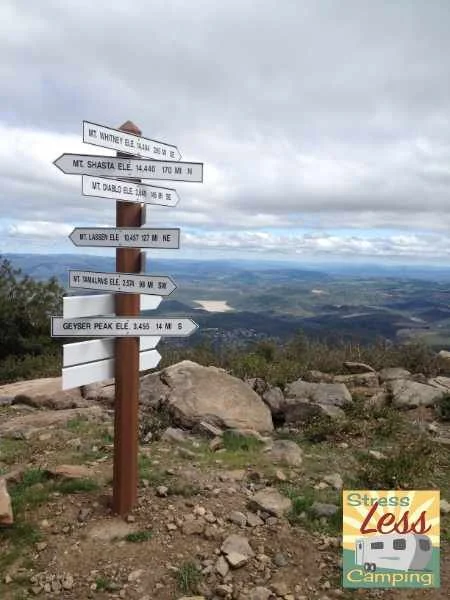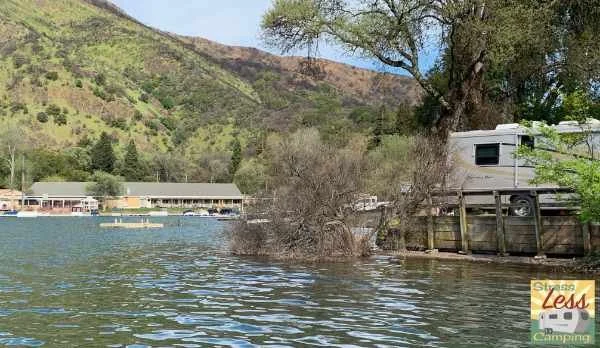Clear Lake - a geological gem for StressLess Camping
Exploring the geology of the second oldest lake in the world
Lake County, California has a long and interesting history of mountain building and lake formation. It’s also a great place to pick up diamonds - but they may not be what you think.
Mount Konocti
A volcano is formed when molten rock (about 2,000 degrees F) pushes up the surface, creating a hill or mountain. When the pressure becomes too great, the earth opens and lava explodes out. The name volcano comes from Volcan, the Roman god of fire.
Mount Konocti is just one of several examples of Lake County’s eruptive history. As the most distinct, youngest, and northernmost volcanic feature in the Clear Lake Volcanic Field, it actually consists of numerous volcanic domes (from slow-moving viscous lavas) and cones (from small, explosive eruptions). The volcanic field dates from 2.1 million years ago to just 10,00 years ago.
Although the Mount Konocti volcano is often called “extinct,” because it has not erupted in the past 10,000 years, it still has a sizable magma body below the volcanic field, and is classified by the US Geological Survey to have High Threat Potential. This magma chamber also powers the world’s largest complex of geothermal power plants. Together, “The Geysers” pants can generate enough power to support two San Franciscos!
Clear Lake
Clear Lake is the largest natural fresh-water lake located entirely in California (Lake Tahoe is larger, but shared with Nevada). It is also among the oldest lake in North America and, at 2.5 million years of age, perhaps among the oldest in the world. While the typical life cycle of a lake ends with sedimentation filling the basin to the point it becomes a swamp, wetland, or meadow Clear Lake is growing at about the same rate it fills with sediments. That growth of Clear Lake is caused by tilting and downward motion of the lakebed, related to earthquake fault and volcanic activities.
A nearly continuous sequence of sediments have been recovered that date back 475,000 years. A history of faults, landslides, and volcanic eruptions has caused a shift of the draining direction of the lake from the Sacramento River to the Russian River, and back again.
With nearly 44,000 acres of surface area, Clear Lake has an average depth of only 27 feet. The average water temperature is warm and the sediments from surrounding hills add nutrients that make the lake very productive. While this productivity is good for fish, fowl, and other life, it can cause an unpleasant experience for us two-legged creatures looking for a crystal-clear lake experience.
The only outlet of Clear Lake is Cache Creek, which contains a rocky ledge called the “Grigsby Riffle” and originally acted as somewhat of a dam to control the lake level. The lowest part of that riffle is known as “Zero Rumsey” and the level is reported in feet above (or below) “Rumsey.” The Cache Creek Dam was build in 1914 and is controlled by Yolo County, which holds the water rights to the lake. Yolo County also controls the Indian Valley Reservoir, with limitations.
Other Lakes
Thirty-six lakes are identified in Lake County. Some are on private property, some are mere swampy areas, and some are well-known recreation areas. Some of the more well-known are listed here:
Blue Lakes are spring-fed, so a shortage of surface water doesn’t really affect these deep, cold lakes that were separated from Clear Lake when landslides separated the two about 10,000 years ago.
Borax Lake: Although listed as a US National Historic Landmark because of extensive cultural deposits dating back as far as 12,000 years ago, this lake is not a place to swim. Hiking in popular in the area around the lake. The water is naturally high in borax, useful in laundry and having anti fungal properties. The borax was mined for some time but no longer is.
Man-made, dammed:
Lake Pillsbury Recreation is a popular location in the Mendocino National Forest created by Scott Dam in 1921. In 1969, performers Jack Haley and Jackie Gleason purchased the Fuller Ranch and created the Pillsbury Ranch subdivision.
Hidden Valley Lake provides recreational opportunities for the approximately 6,000 residents.
Indian Valley Reservoir is within BLM Land and is open to all types of recreation. Indian Valley Dam was built in 1975 to provide irrigation, water storage, and flood control. Primitive camping is available.
Highland Springs Reservoir is popular for kayaking, fishing, picnicking, and hiking.
Girls’ Best Friend
A Lake County diamond found on the ground at Clear Lake Campground.
Lake County Diamonds are clear volcanic glass with hardness of 7.9 to 8 on the Mohs scale. Similar to quartz crystals, which are 7 on the hardness scale, these “diamonds” of silicon dioxide formed in the high heat and pressure conditions of Mount Konocti’s formation.
Breathe Deep
Lake County was ranked by the American Lung Association to have the cleanest air in the nation in 2013-2015, and was ranked 15 in 2019. Massive wildfires since 2015 have decreased the ratings. On 24 different occasions Lake County has been named the cleanest air in California.
All Aboard!
Oh wait, no. No trains here. Lake is the only county in California that doesn’t have a railroad. Except, of course, The Featherbed Railroad Bed & Breakfast!
The Geology of Vegetation
Lake County has a mediterranean climate. The warm, dry summers and cool, mild winters provide ideal conditions for many types of agricultural crops. During Prohibition in the 1920s, vineyards that had been planted in the 1870s were removed in favor of Bartlett pears and walnuts, which are maintained still. However, since the 1960s, the wine industry in Lake County has continued to grow and once again is known for its grapes. Seven American Viticultural Appellations (AVAs) are recognized in Lake County.
The hilly terrain and mediterranean climate of Lake County provides is covered with thick stands of oak, madrone, manzanita, and pines. Hills rise steeply to 7,059 feet above sea level from Clear Lake at 1,329 feet. The warm lake waters provide habitat for catfish, crappie, and carp, and the lake is known as the “bass capital of the west.” The large lake also plays host to a great variety of migratory birds and other water-loving wildlife. One of my favorite parts of the County is the “Black Forest,” named because of the lack of direct sunlight between heavy stands of Douglas fir.
There is a good deal of serpentine rock in Lake County, due to the extensive area faulting. While there is naturally-occurring asbestos in serpentine soils, which can cause cancer and other diseases if inhaled or swallowed, the serpentine soils also support a variety of specially-adapted and often “rare” (as listed by the California Native Plant Society) plants.
Dr. Harry Lyons did a Facebook live that is very informative and entertaining: https://fb.watch/5M1uvtoZJH/





